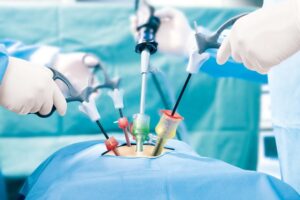Laparoscopic Surgery: What It Is, Its Advantages, and How It Can Help You
What Is Laparoscopic Surgery and What Are the Benefits?
Laparoscopic or “minimally invasive” surgery is a specialized technique for performing surgery. Over the last 10 years, the use of this technique has expanded into intestinal surgery.
How Does Laparoscopic Surgery Work?
Laparoscopy is a type of surgery that involves smaller cuts than you might think. The laparoscope, a narrow piece of equipment with a tiny video camera and light on the end gives the procedure its name.
Surgical methods have advanced dramatically over time, and much newer, safer, and better surgical methods have emerged, improving the quality of life for surgical patients; one of them is laparoscopic surgery. Minimally invasive surgery is another name for it.


When a surgeon inserts the laparoscope into your body through a small cut, they can view what’s inside you on a video display, where it’s better viewed up to 30 times, bigger, and with high definition. They’d have to construct a far larger opening if they didn’t have that equipment.
Laparoscopic approach is used for many surgeries. It has the advantages of less pain, less cutting of skin and tissue, fewer wound complications, quicker post-operative recovery, and a shorter duration of hospital stay.
Benefits
When compared to standard surgery, this method has various benefits. Because it necessitates less invasive:
- Your scars are smaller.
- You can leave the hospital sooner.
- While the scars heal, you will have less pain and they will heal faster.
- You can resume your regular activities sooner.
- Internal scarring can be reduced.
If you have laparoscopic surgery, you may only need to stay in the hospital for less than 24 hours and recuperate in 4 to 7 days. A shorter hospital stay is also less expensive.
What kind of operations can laparoscopic surgery be used for?
The laparoscopic approach can be used for most intestinal procedures. Concerns about the safety of laparoscopic surgery have been raised in the past. Several studies involving hundreds of patients recently concluded that laparoscopic surgery is safer for certain types of abdominal surgery.
The following are some of the benefits of this treatment over open surgery:
- Because the incision made is so much smaller than the big incision made for open surgery, the danger of bleeding during the operation is reduced. This lowers the chances of requiring a blood transfusion to compensate for blood loss.
- The smaller incision also minimizes the likelihood of post-surgery pain and bleeding. Patients frequently require long-term pain management medication while the stitch line heals after a major incision. The post-surgical wound is substantially smaller, and the healing process is far less unpleasant than with open surgery.
- The smaller incision also means that the scar left behind after surgery is smaller. The scar tissue that forms in cases where the surgical site is larger is more prone to get infected and vulnerable to herniation, especially in overweight and obese people.
- When compared to open surgery, the exposure of internal organs to external pollutants is greatly minimized with laparoscopic surgery, lowering the risk of postoperative infection.
- Because laparoscopic surgery heals so quickly, the amount of time spent in the hospital is considerably reduced. Most patients are discharged the same day or the next day, allowing them to resume their daily routines substantially sooner than they would after an open surgery operation.
Benefits for the patient
Laparoscopic surgery provides the advantage of avoiding big open wounds or incisions, resulting in less blood loss, pain, and discomfort for the patient. Because less anesthesia is necessary, patients experience fewer ill effects. Tissue trauma and blood loss are less likely with fine devices. In general, the rate of postoperative complications is lower. Performance of the operation within the body cavity avoids the cooling, drying, excessive handling, and retraction of internal organs associated with conventional ‘open’ techniques.
Laparoscopic surgery reduces the amount of direct contact between the surgeon and the patient, lowering the chance of the surgeon contracting a virus from the patient or vice versa. This is because sensitive tissues are not exposed to the operating room air for long periods. Surgeons can see the sick organ and its accompanying arteries and nerves better using video magnification. As a result, precise techniques can be undertaken during surgery to protect these tissues.
The ideal surgical option is laparoscopic surgery, which is beneficial in problems that may be addressed with minimally invasive medical techniques. The procedure is a very common and straightforward treatment, and it has fewer drawbacks and more advantages.
Laparoscopy enables the creation of a tailored treatment or surgical strategy by providing in-depth, realistic insights into the patient’s actual condition. Laparoscopy can also be used to treat minor ailments. As a result, laparoscopy can be utilized for both diagnostic and surgical procedures.
Finally, laparoscopic surgery has enabled us to do many of our surgeries in a method that produces excellent results while minimizing the disturbance and risk that standard surgery typically entails. This implies you’ll be able to heal faster and resume your normal routine.
Please contact us at VIDA If you have any questions about our laparoscopic procedures. We will be happy to help you know more about this procedure.